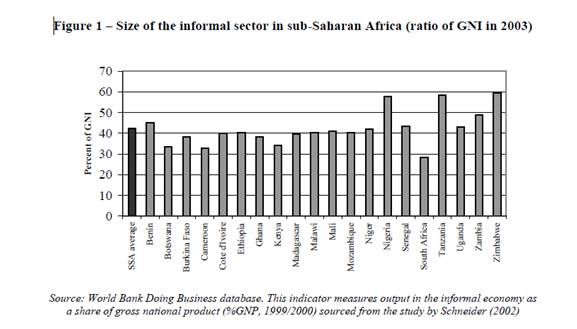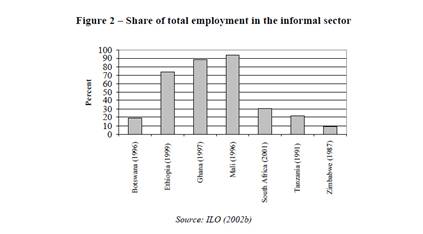Data response (1)
Source: http://www.iza.org/conference_files/worldb2006/verick_s872.pdf
The World Bank as part of its work on benchmarking business regulations has developed a measure of the size of the informal economy. The methodology for estimating this indicator is based on the study by Schneider (2002). Using this data, Figure 1 graphs the size of the informal economy as a percentage of gross national income (GNI), which ranges from under 30 percent in South Africa, the continent's largest economy, to almost 60 percent in Nigeria, Tanzania and Zimbabwe. The average in sub-Saharan Africa (SSA) is 42.3 percent.


Turning to the labour market, based on figures reported in ILO (2002a) the informal sector in SSA is estimated to represent around three-quarters of non-agricultural employment. According to ILO (2002c), the sector amounts to 72 percent of employment in sub-Saharan Africa, 78 percent if South Africa is excluded. Statistics reported in Chen (2001) suggest that 93 percent of new jobs created in Africa during the 1990s were in the informal sector, reflecting the impact of globalization, economic reforms and competitive pressures on the labour market in recent years.
ILO (2002b) reports on the share of employment in the informal sector for a number of African countries based on the harmonised and national definitions.1 Figure 2 presents the share of total employment in the informal sector using the national definition for a number of African countries. Though the figures are for different years, it is clear that the share of informal employment varies considerably within Africa, ranging from 8.8 percent in Zimbabwe to 94.1 percent in Mali.

Question 1
Define the term 'informal sector'.
Question 2
Identify the type of activities provided by the informal sector?
Question 3
Examine the impact of a strong informal sector impact on the reliability of GDP figures as an indicator of economic development.
Question 4
Analyse the benefits and the costs of African governments encouraging the growth of the informal sector.
